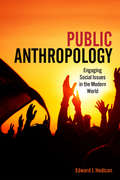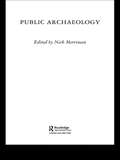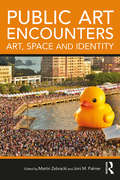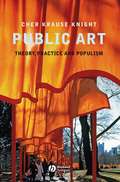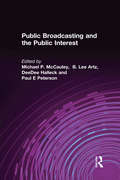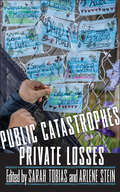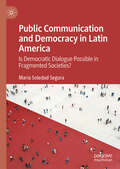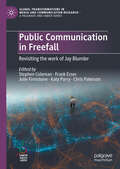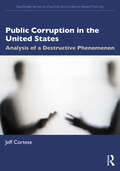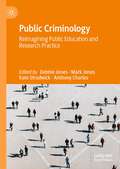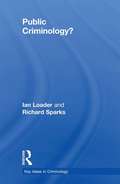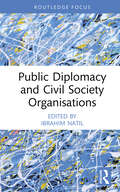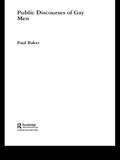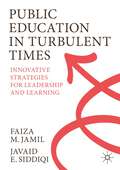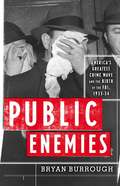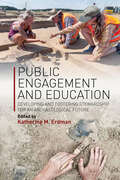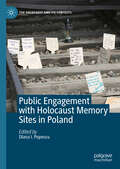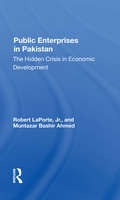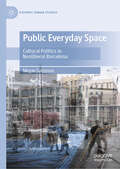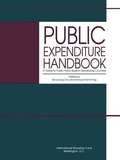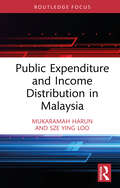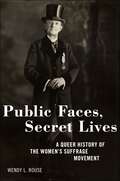- Table View
- List View
Public Anthropology: Engaging Social Issues In The Modern World
by Edward J. HedicanContemporary anthropology has changed drastically in the new millennium, expanding beyond the anachronistic study of "primitive" societies to confront the burning social, economic, and political challenges of the day. In the process, anthropologists often come face to face with issues that require them to take a public position—issues such as race and tolerance, health and well-being, food security, reconciliation and public justice, global terror and militarism, and digital media This comprehensive but accessible book is both an interesting read and an excellent overview of public anthropology. In-depth case studies offer an opportunity to evaluate the pros and cons of engaging with public issues, while profiles of select anthropologists ensure the book is contemporary, but rooted in the history of the discipline.
Public Archaeology: The Past, The Heritage And The Public, Second Edition (University College London Institute Of Archaeology Publications)
by Nick MerrimanScrutinizing, in detail, the relationship between archaeology, heritage and the public, this much-needed volume explores public interest and participation in archaeology as a subject worthy of academic attention in its own right. Examining case studies from throughout the world; from North America, Britain, Egypt and Brazil to East Africa, China and beyond, Nick Merriman focuses on two key areas: communication and interpretation, and stakeholders. Constant reports of new discoveries, protests over the destruction of sites and debates over the return of artefacts such as the Elgin marbles or indigenous remains testify to an increasing public interest in archaeology. For students and scholars of this archaeology, and of its relationship with the public, this will prove essential reading.
Public Art Encounters: Art, Space and Identity
by Martin Zebracki Joni M. PalmerPublic art is produced and ‘lived’ within multiple, interlaced and contested political, economic, social and cultural-symbolic spheres. This lively collection is a mix of academic and practice-based writings that scrutinise conventional claims on the inclusiveness of public art practice. Contributions examine how various social differences, across class, ethnicity, age, gender, religion, ability and literacy, shape encounters with public art within the ambits of the design, regeneration and everyday experiences of public spaces. The chapters richly draw on case studies from the Global North and South, providing comprehensive insights into the experiences of encountering public art via a variety of scales and realms. This book advances critical insights of how socially practised public arts articulate and cultivate geographies of social difference through the themes of power (the politics of encountering), affect (the embodied ways of encountering), and diversity (the inclusiveness of encountering). It will appeal to scholars, students and practitioners of cultural geography, the visual arts, urban studies, political studies and anthropology.
Public Art: Theory, Practice and Populism (Blackwell Companions To Art History Ser.)
by Cher Krause KnightThis book takes a bold look at public art and its populist appeal, offering a more inclusive guide to America's creative tastes and shared culture. It examines the history of American public art – from FDR's New Deal to Christo's The Gates – and challenges preconceived notions of public art, expanding its definition to include a broader scope of works and concepts. Expands the definition of public art to include sites such as Boston's Big Dig, Las Vegas' Treasure Island, and Disney World Offers a refreshing alternative to the traditional rhetoric and criticism surrounding public art Includes insightful analysis of the museum and its role in relation to public art
Public Broadcasting and the Public Interest (Media, Communication, And Culture In America Ser.)
by Paul E Peterson Michael P. McCauley B. Lee Artz DeeDee HalleckAs federal funding for public broadcasting wanes and support from corporations and an elite group of viewers and listeners rises, public broadcasting's role as vox populi has come under threat. With contributions from key scholars from a wide variety of disciplines, this volume examines the crisis facing public broadcasting today by analyzing the institution's development, its presentday operations, and its prospects for the future. Covering everything from globalization and the rise of the Internet, to key issues such as race and class, to specific subjects such as advertising, public access, and grassroots radio, Public Broadcasting and the Public Interest provides a fresh and original look at a vital component of our mass media.
Public Catastrophes, Private Losses (The Feminist Bookshelf: Ideas for the 21st Century)
by Naomi Klein Marcia Gallo Christina Sharpe Ellen Malenas Ledoux Kathleen C. Riley Basuli Deb Marisa J. Fuentes Carmen Vázquez Michelle Commander Jennifer Flynn Walker Bela August Walker Smruthi Bala Kannan Stacy S. Klein Leslye Amede ObioraFrom COVID to climate-change-induced wildfires and hurricanes, we live in an era when catastrophes have become the new normal. But even though these events affect us all, some members of society are more vulnerable to harm than others. This essay collection explores how the definition of catastrophe might be expanded to include many forms of large-scale structural violence on communities, species, and ecosystems. Using feminist methodologies, the contributors to Public Catastrophes, Private Losses trace the connections between seemingly unrelated forms of violence such as structural racism, environmental degradation, and public health crises. In contrast to a news media that focuses on mass fatalities and immediate consequences, these essays call our attention to how catastrophes can also involve slow violence with long-term effects. The authors also consider how these catastrophes are profoundly shaped by government action or inaction, offering a powerful critique of how government neglect has cost lives and demonstrating how vulnerable populations can be better protected. The essays in this collection examine how public catastrophes imprint themselves on lives, as individuals and communities narrate, process, and grapple with legacies of loss. The book is thus a feminist intervention that challenges the binary between public and private, personal and political.
Public Choice III
by Dennis C. MuellerThis book represents a considerable revision and expansion of Public Choice II (1989). Six new chapters have been added, and several chapters from the previous edition have been extensively revised. The discussion of empirical work in public choice has been greatly expanded. As in the previous editions, all of the major topics of public choice are covered. These include: why the state exists, voting rules, federalism, the theory of clubs, two-party and multiparty electoral systems, rent seeking, bureaucracy, interest groups, dictatorship, the size of government, voter participation, and political business cycles. Normative issues in public choice are also examined including a normative analysis of the simple majority rule, Bergson-Samuelson social welfare functions, the Arrow and Sen impossibility theorems, Rawls's social contract theory and the constitutional political economy of Buchanan and Tullock.
Public Communication and Democracy in Latin America : Is Democratic Dialogue Possible in Fragmented Societies?
by María Soledad SeguraThe book examines alternatives proposed and implemented by governments, civil society organizations, social movements and companies in Latin America to democratize public communication and overcome its current problems, such as the dissemination of alternative facts and fake news, anti-scientific discourse, harassing, discriminatory and hate speech, anti-human rights and anti-democracy discourses, and the contempt for political correctness. Drawing on theoretical approaches from media and communication, political studies and sociology, the book identifies strengths and weaknesses of the strategies for promoting democratic dialogue in Latin America and globally.
Public Communication in Freefall: Revisiting the work of Jay Blumler (Global Transformations in Media and Communication Research - A Palgrave and IAMCR Series)
by Stephen Coleman Frank Esser Katy Parry Julie Firmstone Chris PatersonThis book addresses key challenges facing global political communication at a time in which transformations in political practice, media ecology and cultural expectations both threaten traditional democratic norms and point to potential new ways of enacting political democracy. Drawing upon the outstanding theoretical insights of Jay Blumler to our understanding of the norms and practices of political communication, but also critically interrogating and updating them where appropriate, the volume asks timely questions about what publicness and democracy mean in the 2020s. Many people are talking and writing about the crisis of political democracy, fewer are talking about the role of the media in relation to that crisis. While many scholars have responded in an ad hoc way to the various crises of populism, polarisation, mis and disinformation, this book shows how Jay Blumler’s scholarship provides us with the tools and framework to research and understand the changing communication environment systemically and rigorously. The book demonstrates the applicability and relevance of Blumler’s work in explicating the current crisis of communication and the need for fresh and radical thinking in tackling it. The book's breadth and depth of chapters from a broad range of scholars from the East and West, ranging from long-standing contributors to the field to those in the early stages of their career, combine to produce a thoughtful and provocative invitation to reflect upon the concept of a ‘crisis of public communication’. We expect this book to become a major source for political communication students and scholars.
Public Corruption in the United States: Analysis of a Destructive Phenomenon (Routledge Series on Practical and Evidence-Based Policing)
by Jeff CortesePublic Corruption in the United States provides a comprehensive view of public corruption, including discussion on its types, methods, trends, challenges, and overall impact. It is the first book of its kind to examine in plain language the breadth of criminal public corruption in the United States, not just at a superficial level, but in a deeper context. By critically examining acts of corruption of elected, appointed and hired government officials (legislators, law enforcement, judges, etc.) at the local, state, and federal levels, the reader gains insight into the inner workings of corruption, including its relationship to terrorism and organized criminal networks. Using simple language and easy-to-understand examples, this book is about empowering investigators, compliance professionals, educators, public officials, and everyday citizens who seek to better serve, support, and protect their communities and their country.
Public Criminology: Reimagining Public Education and Research Practice
by Anthony Charles Mark Jones Debbie Jones Kate StrudwickThis book discusses the role and impact of ‘Public Criminology’. It brings together a collection of key scholars who have been at the fore of empirical and practice work in relation to understanding how ‘Public Criminology’ can engender academic activism. Split into two parts, it focusses on academic activism and research methodologies, and public criminology and pedagogical practice. It includes chapters on a range of topics including Inside-Out teaching, it discusses the role of social scientists and stepping outside of established research practices, and how students, the public and children can be engaged in criminological learning and issues to become agents of social change. It includes a reflection on how ‘Public Criminology’ has developed both in the UK and USA. It speaks to students, researchers and academics alike involved in teaching and learning within the discipline of Criminology and those who wish to evaluate practice and ensure their interventions have impact on commissioners and policymakers.
Public Criminology? (Key Ideas in Criminology)
by Ian Loader Richard SparksWhat is the role and value of criminology in a democratic society? How do, and how should, its practitioners engage with politics and public policy? How can criminology find a voice in an agitated, insecure and intensely mediated world in which crime and punishment loom large in government agendas and public discourse? What collective good do we want criminological enquiry to promote? In addressing these questions, Ian Loader and Richard Sparks offer a sociological account of how criminologists understand their craft and position themselves in relation to social and political controversies about crime, whether as scientific experts, policy advisors, governmental players, social movement theorists, or lonely prophets. They examine the conditions under which these diverse commitments and affiliations arose, and gained or lost credibility and influence. This forms the basis for a timely articulation of the idea that criminology’s overarching public purpose is to contribute to a better politics of crime and its regulation. Public Criminology? offers an original and provocative account of the condition of, and prospects for, criminology which will be of interest not only to those who work in the fields of crime, security and punishment, but to anyone interested in the vexed relationship between social science, public policy and politics.
Public Diplomacy and Civil Society Organisations (Routledge Explorations in Development Studies)
by Ibrahim NatilThis book explores the roles of civil society organisations (CSOs) when engaging in public diplomacy activities and their impact on community development and change. It provides up-to-date analysis of the challenges and constraints facing CSOs involved in diplomatic missions and working with foreign donors. Bringing together case studies from Cameroon, Egypt, Poland, Palestine, Lebanon and Libya, this edited collection reflects on how external calls for proposals in the fields of women’s empowerment, community development, education, training, exchange programmes, democracy, human rights and peacebuilding influence the way civil society organisations contribute, deliver, intervene and position themselves in various societies. It explores the lessons learnt by various CSOs in identifying societal problems, understanding grassroots demands, prioritising development agendas and campaigning for peacebuilding. Grounded in a firm theoretical framework and based on up-to-date empirical research, the book reflects on the leadership shown by civil society organisations in development, politics and business and their impact on community development initiatives and local change process. This book will be an important resource for researchers, policymakers, donors, NGO practitioners and the beneficiaries themselves, within the areas of international development, peacebuilding, civil society, politics and international relations.
Public Discourses of Gay Men (Routledge Advances in Corpus Linguistics #Vol. 8)
by Paul BakerQueer linguistics has only recently developed as an area of study; however academic interest in this field is rapidly increasing. Despite its growing appeal, many books on ‘gay language’ focus on private conversation and small communities. As such, Public Discourses of Gay Men represents an important corrective, by investigating a variety of sources in the public domain. A broad range of material, including tabloid newspaper articles, political debates on homosexual law and erotic narratives are used in order to analyse the language surrounding homosexuality. Bringing together queer linguistics and corpus linguistics the text investigate how gay male identities are constructed in the public domain.
Public Economics
by Gareth D. MylesThis textbook provides a thorough treatment of all the central topics in public economics. Aimed at senior undergraduate and graduate students, it will also be invaluable to professional economists and to those teaching in the field. The book is entirely self-contained, giving all the equilibrium theory and welfare economics needed to understand the analyses. The author covers the Arrow-Debreu economy, welfare economics and the measurement of inequality and poverty which lay the foundations and emphasise the important role played by information. Within the competitive economy, he examines commodity taxation, income taxation and tax reform in a certain environment. He goes on to study the public economics of uncertainty, and then treats public goods, externalities, imperfect competition and tax evasion as departures from the standard competitive assumptions and looks at their implication for public economics derived.
Public Education in Turbulent Times: Innovative Strategies for Leadership and Learning
by Faiza M. Jamil Javaid E. SiddiqiPublic Education in Turbulent Times communicates a bold vision for the future of education, addressing the evolving purpose of American public education and the structural innovations schools are using to meet the needs of a rapidly transforming world. Highlighting key challenges that emerged during the immense economic and social disruptions of recent years, the book leverages case studies of four unique school districts where school communities overcame concerns high in the public consciousness – trauma, danger, economic inequality, and racial injustice. These obstacles have hampered efforts to reclaim lost learning opportunities that could define the educational experiences of a generation of students. If educators revert to business as usual, they risk dismissing essential lessons from resilient schools that thrived in the chaos of a global pandemic and its fallout. This book provides rich insights to refocus readers’ attention on achieving a more equitable and safe education system for the future.
Public Enemies: America's Greatest Crime Wave and the Birth of the FBI, 1933-34
by Bryan BurroughThe establishment of the FBI as a force against gang crime in the early 1930's.
Public Engagement and Education: Developing and Fostering Stewardship for an Archaeological Future
by Katherine M. ErdmanThe world’s collective archaeological heritage is threatened by war, development, poverty, climate change, and ignorance. To protect our collective past, archaeologists must involve the general public through interpersonal experiences that develop an interest in the field at a young age and foster that interest throughout a person’s life. Contributors to this volume share effective approaches for engaging and educating learners of all ages about archaeology and how one can encourage them to become stewards of the past. They offer applied examples that are not bound to specific geographies or cultures, but rather, are approaches that can be implemented almost anywhere.
Public Engagement with Holocaust Memory Sites in Poland (The Holocaust and its Contexts)
by Diana I. PopescuThis book aims to address a neglected field of research by providing evidence-based insights into how contemporary visitors of different national and generational background, especially those of Polish and Jewish descent, experience and reflect on their visits, or on living in the proximity of different sites of memory across Poland, including former concentration and death camps, ghetto sites, and other physical sites such as museums with a connection to the Holocaust.
Public Enterprises In Pakistan: The Hidden Crisis In Economic Development
by Robert Laporte Muntazar Bashir AhmedThis book contains a study of the economics and management of public enterprises in Pakistan. It examines their performance, organizational behavior, relationships with other government organizations outside of the sector, and the issues that confront the public enterprise sector and the government.
Public Everyday Space: Cultural Politics in Neoliberal Barcelona (Hispanic Urban Studies)
by Megan SaltzmanThis book explores how everyday practices in public space (sitting, playing, walking, etc.) challenge the increase of top-down control in the global city. Public Everyday Space focuses on post-Olympic Barcelona—a time of unprecedented levels of gentrification, branding, mass tourism, and immigration. Drawing from examples observed in public spaces (streets, plazas, sidewalks, and empty lots), as well as in cultural representation (film, photography, literature), this book exposes the quiet agency of those excluded from urban decision-making but who nonetheless find ways to carve out spatial autonomy for themselves. Absent from the map or postcard, the quicksilver spatial phenomena documented in this book can make us rethink our definitions of culture, politics, inclusion, legality, architecture, urban planning, and public space.
Public Expenditure Handbook
by Richard Hemming Ke-Young ChuA report from the International Monetary Fund.
Public Expenditure and Income Distribution in Malaysia (Routledge Contemporary Southeast Asia Series)
by Mukaramah Harun Sze Ying LooThis book studies the impact of public expenditure allocations in achieving income equality goals in Malaysia. The book examines the initial functional and institutional distribution of income across different institutional agents and sectors and evaluates the impact of the public expenditure policies in reducing the inter-ethnic and rural–urban disparity. Since Malaysia has made enormous progress in eliminating poverty, the authors suggest that a change of emphasis in the public expenditure policy may now be called for. They present evidence on the importance of public expenditure in improving income inequality and examine the initial functional and institutional distribution of income across different institutional agents and sectors. The development of the Social Accounting Matrix (SAM) model that presents both economic and social statistics in an economy can be served as a useful tool of this work. The SAM model is used to evaluate the impact of the public expenditure policies in reducing inter-ethnic and rural–urban disparity. A comprehensive source of information on how to deal with inequality economic challenges, the book will be of interest to economists and researchers on Southeast Asian Studies.
Public Faces, Secret Lives: A Queer History of the Women's Suffrage Movement
by Wendy L. RouseHonorable Mention for the 2023 Francis Richardson Keller-Sierra Prize2023 Judy Grahn Award-Publishing Triangle FinalistRestores queer suffragists to their rightful place in the history of the struggle for women’s right to voteThe women’s suffrage movement, much like many other civil rights movements, has an important and often unrecognized queer history. In Public Faces, Secret Lives Wendy L. Rouse reveals that, contrary to popular belief, the suffrage movement included a variety of individuals who represented a range of genders and sexualities. However, owing to the constant pressure to present a “respectable” public image, suffrage leaders publicly conformed to gendered views of ideal womanhood in order to make women’s suffrage more palatable to the public.Rouse argues that queer suffragists did take meaningful action to assert their identities and legacies by challenging traditional concepts of domesticity, family, space, and death in both subtly subversive and radically transformative ways. Queer suffragists also built lasting alliances and developed innovative strategies in order to protect their most intimate relationships, ones that were ultimately crucial to the success of the suffrage movement. Public Faces, Secret Lives is the first work to truly recenter queer figures in the women’s suffrage movement, highlighting their immense contributions as well as their numerous sacrifices.
Public Feminisms: From Academy to Community
by Carrie N. Baker Aviva Dove-ViebahnA city walking tour that subverts tourists’ assumptions about sex workers. Collaborative performances that offer participants a way to understand the stories of disappeared and murdered Indigenous women. Testimony before a state legislature on the harmful impact of parental consent laws for minors seeking abortion health care. A public film and discussion series encouraging intersectional feminist analysis. A Writing Center employing a Black feminist approach to teach writing to community members. These are just some of the stories told in this volume. Through art and public programming, activism and policy advocacy, public writing and community education, feminists in higher education are using scholarly methods and pedagogies to share academic knowledge and research with their communities at the local, national and international levels. These scholars are advancing public knowledge about issues affecting women and girls, racial and ethnic minorities, immigrants, Indigenous peoples, LGBTQAI individuals, and others facing discrimination, lacking resources, or experiencing economic, political and social injustices. This book offers a selection of case studies, models, narratives and tools from a diverse array of writers whose essays the editors have carefully curated to showcase myriad strategies for community engagement. Accessible and engaging to a broad range of readers, the essays in this volume are a rich resource for scholars interested in infusing their academic knowledge into the public sphere. This volume offers an opportunity to reflect on the meaning and importance of community engagement for scholars, and archives some of the important public-facing work feminists are doing today.
